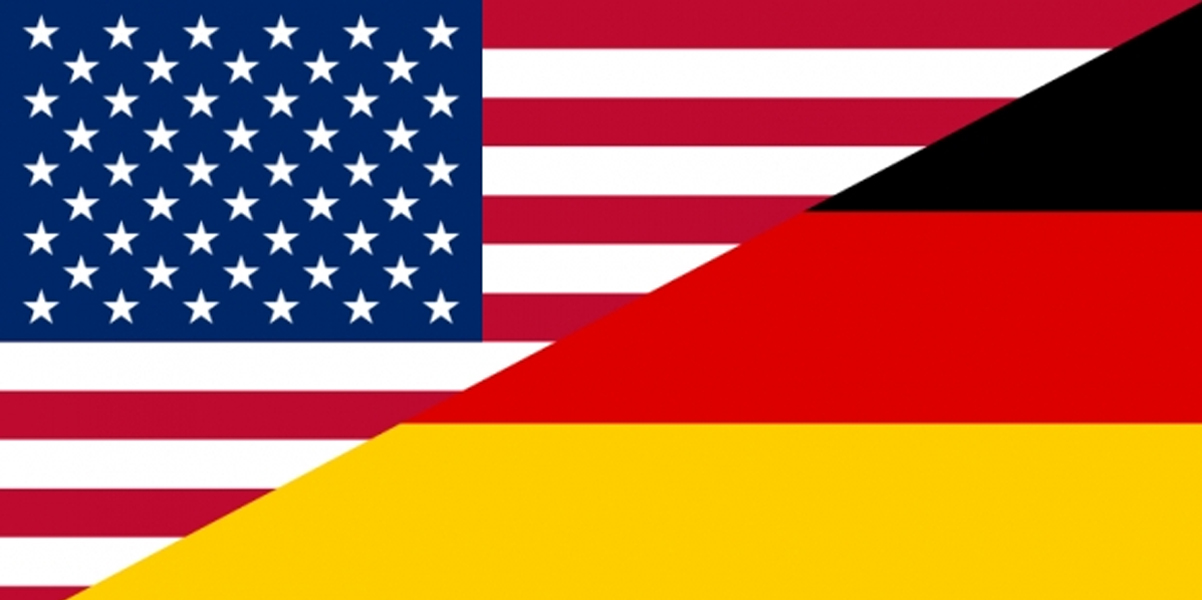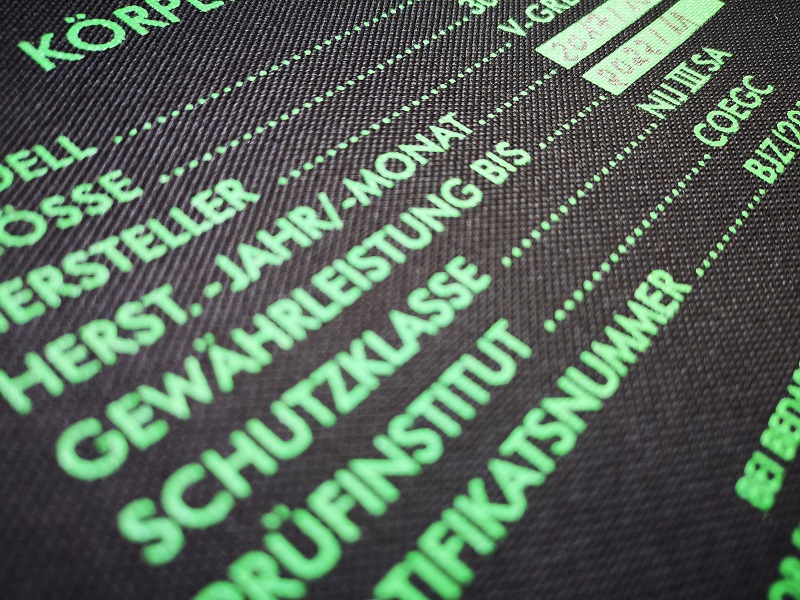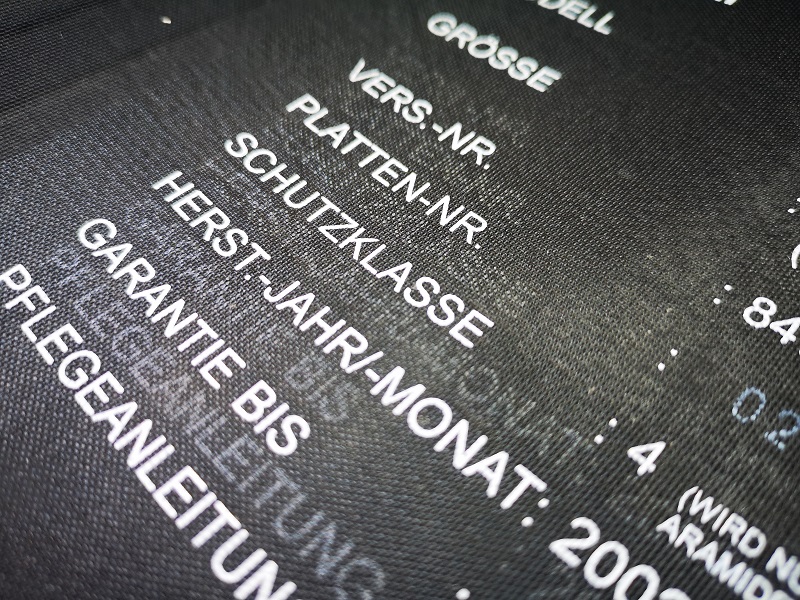Get the weekly SPARTANAT newsletter.
Your bonus: the free E-Book from SPARTANAT.

BASICS: Protection classes USA versus Germany
The question often arises of what the difference is between the American NIJ Standard and the German Technical Guideline Ballistic Protection Vests (TR). At first glance, there are many similarities: 5 protection levels and partly similar calibers.
However, there are also several differences that are not immediately obvious. It cannot be said categorically that the NIJ Standard or the German TR is better. It depends much more on the threat situation the wearer is facing and which characteristics he wants to prioritize. Is multi-hit protection or protection against large calibers the priority? Light weight or trauma reduction?
Depending on the requirements, a different ballistic standard is recommended. To clarify any uncertainties, we will explore the two ballistic standards and their peculiarities.
NIJ Standard 0101.06
 The NIJ Standard is the ballistic standard of the American National Institute of Justice. Since 1972, it has been the only nationally accepted standard in the USA and has also become the leading standard worldwide. The goal of the NIJ Standard was to determine the minimum ballistic performance that must be achieved.
The NIJ Standard is the ballistic standard of the American National Institute of Justice. Since 1972, it has been the only nationally accepted standard in the USA and has also become the leading standard worldwide. The goal of the NIJ Standard was to determine the minimum ballistic performance that must be achieved.
The NIJ Standard 0101.06 is the current American standard from 2008. It is divided into 5 protection levels: Type IIa, Type II, Type IIIa, Type III, and Type IV. The ballistic requirements of the classes are as follows:
| Type | Caliber | Bullet Type | Mass | Speed |
| IIa | 9 x 19 mm
.40 S&W |
Full Metal Jacketed
|
8.00 grams | 373 +/- 9.1 m/s |
| II | 9 x 19 mm
.357 Magnum |
Full Metal Jacketed
Jacketed Soft Point |
8.00 grams
6.00 grams |
398 +/- 9.1 m/s
436 +/- 9.1 m/s |
| IIIa | .357 SIG (9 x 22 mm)
.44 Magnum |
Full Metal Jacketed Flat Nose
Semi Jacketed Hollow Point |
8.1 grams
15.6 grams |
448 +/- 9.1 m/s
436 +/- 9.1 m/s |
| III | 7.62 x 51mm (M80) | Steel Jacketed | 9.6 grams | 847 +/- 9.1 m/s |
| IV | 7.62 x 63 mm (M2 AP) | Armor Piercing | 10.8 grams | 878 +/- 9.1 m/s |
For types IIa to IIIa, 6 shots are fired per insert. Of these, 4 shots are fired at an angle of 0° (NATO angle) and one at angles of 30° and 45° each. From type III onwards, only shots are fired at 0° angle. For type III, 6 shots are fired, and for type IV, 1 to 6 shots are fired. The shooting distance is 5 m for types IIa-III and 15 m for type IV.
In addition, a wet test is carried out for types IIa-IIIa. The inserts are immersed in 21°C warm water vertically for 30 minutes, followed by 10 minutes of draining. This is to ensure that even wet ballistic material maintains its performance.
A wear test is conducted to simulate several years of wearing. After all, a vest that has been worn for a long time should not lose its ballistic protection. In general, the wear test is a good indicator of the quality of a protective vest. The better the result, the more resistant a vest is to environmental influences, and the wearer can rely on its ballistic protection despite rough conditions. The wear test includes a 10-day abrasion test at 65°C with 72,000 +/- 1500 revolutions at 80% humidity for types IIa-IIIa. However, a lower muzzle velocity is used for the subsequent shooting test to account for the conditioning.
The wear test for hard ballistic material of classes III and IV must meet significantly higher requirements. They are exposed to 65°C and 80% humidity for 10 days without rotation. They are then climatized and must withstand large temperature variations between -15°C to +90°C for 24 hours with a humidity of 0-50%. A drop test is then carried out to ensure that the ballistic material can withstand light shocks. In addition, the plates are immersed in water and then shot while wet.
For all types, the NIJ Standard 0101.06 sets a maximum trauma of 44 mm. The NIJ Standard does not include a stab test; this is covered in a separate standard.
Technical Guideline Ballistic Protection Vests
 The Technical Guideline Ballistic Protection Vests (TR) is the ballistic standard in Germany. Based on the TR, the police and the Bundeswehr (German army) source their ballistic protective equipment. The technical guideline has existed since 1979 and is an established standard, especially in the German-speaking region. However, it has never achieved the same level of dissemination as the American NIJ Standard. Therefore, internationally, the TR is considered a niche standard. Nevertheless, the German standard has some peculiarities that should not be underestimated.
The Technical Guideline Ballistic Protection Vests (TR) is the ballistic standard in Germany. Based on the TR, the police and the Bundeswehr (German army) source their ballistic protective equipment. The technical guideline has existed since 1979 and is an established standard, especially in the German-speaking region. However, it has never achieved the same level of dissemination as the American NIJ Standard. Therefore, internationally, the TR is considered a niche standard. Nevertheless, the German standard has some peculiarities that should not be underestimated.
The Technical Guideline Ballistic Protection Vests is also divided into 5 protection classes, which, unlike the NIJ Standard, also have a specific definition:
- Class L: Protection against bullets from "common" handguns
- Class 1: Protection against bullets from submachine guns
- Class 2: Protection against bullets from all handguns
- Class 3: Protection against standard bullets from rifles
- Class 4: Protection against hard core bullets from rifles
The ballistic requirements of the classes are as follows:
| SK | Caliber | Bullet Type | Mass | Speed |
| L | 9 x 19 mm | Steel jacketed, round head, lead-soft core, tinned | 8.00 grams | 360 m/s +/- 10 m/s |
| 1 | 9 x 19 mm | Steel jacketed, round head, lead-soft core, tinned
QD-PEP II/S (Police special bullet) Action 4 (Police special bullet) |
8.00 grams
6.00 grams 6.10 grams |
415 m/s +/- 10 m/s
460 m/s +/- 10 m/s 460 m/s +/- 10 m/s |
| 2 | .357 Magnum | Full brass, conical head | 7.10 grams | 580 m/s +/- 10 m/s |
| 3 | .223 Remington
(5.56 x 45 mm) .308 Winchester (7.62 x 51 mm) |
Steel jacketed, pointed head, lead-soft core with steel penetrator
Steel jacketed, pointed head, lead-soft core |
4.00 grams
9.55 grams |
950 m/s +/- 10 m/s
830 m/s +/- 10 m/s |
| 4 | .308 Winchester
(7.62 x 51 mm) |
Steel jacketed, pointed head, hardened steel core | 9.70 grams | 820 m/s +/- 10 m/s |
For SK L to SK 1, 4 shots are fired at an angle of 0°. This is followed by an angle test with 3 shots at 65° and 3 shots placed at 0°. The shooting test with police ammunition does not include shooting at 0°.
From SK 2 to SK 4, 3 shots at 0° and 3 shots at 65° are tested. Separate inserts are used for each type of shooting. Therefore, for example, there is no shooting at 0° and a shooting at 65° on the same ballistic insert. The shooting distance is, except for the placed shot, 5 m for SK L to SK 2 and 10 m from SK 3 onwards.
Protection vests of level SK L or SK 1 are tested against a placed shot. In this test, the barrel of the weapon is pressed against the insert with 10 kg of pressure and 3 shots are fired at the insert. If a physical confrontation occurs, the protective vest should still withstand shots from close range. Depending on the construction, not every protective vest may be capable of this.
To test the abrasion resistance of soft ballistic material, the TR also requires a wear test and conditioning of the test samples.
A cold/hot test is carried out. Each insert is stored in a climate chamber vertically for 16 hours at -20°C, at +20°C and 65% humidity, and at +70°C.
During the actual wear test, the insert is stored vertically or hanging at +40°C and 90-95% humidity for at least 16 hours. What is noteworthy here is that if the ballistic package is sealed in a moisture-resistant cover, it must be removed from the cover. This means that the actual ballistic material is unprotected from heat and humidity. The wear test directly tests the resistance of the material and its processing. The TR specifies a lifespan of 10 years for a protective vest.
The TR distinguishes between trauma values for undergarment and overgarment protective vests. Undergarment protective vests worn covertly under clothing and closer to the body may have a maximum trauma value of 40 mm. The TR is oriented towards the American NIJ Standard in this regard. On the other hand, for overgarment protective vests, the TR sets a maximum trauma value of 22 mm. The TR has a different basic concept here. Undergarment protective vests should only allow the wearer to escape from a dangerous situation. The readiness of the wearer is not necessarily guaranteed by the higher trauma after a hit with an undergarment protective vest.
Overgarment protective vests, on the other hand, should ensure the readiness of the wearer even after being hit. Consequently, a much lower trauma value is set for overgarment protective vests. Overgarment protective vests target wearers in tactical situations such as soldiers or special forces who can wear the vest openly.
Like the NIJ Standard, the TR does not include a stab test. This is covered in a separate stab protection standard.
Conclusion
“Same, same but different.” In general, it can be said that the German standard tests more threat scenarios. The placed shot and the test with police special bullets are missing in the American NIJ Standard. However, the American standard tests large calibers with high stopping power.
While smaller calibers and lighter bullets are used on the German side, they are more aggressive in terms of penetrating power. The TR tests with full metal jacket projectiles from as early as SK L, while on the American side, only normal full metal jacket bullets are used, followed by more ammunition with high penetration power.
Furthermore, SK 4 is tested with three shots, while NIJ Level IV only needs to withstand at least one shot. However, Level IV protects against the significantly stronger caliber 7.62 x 63 mm.
Regarding trauma, the NIJ Standard allows a maximum of 44 mm across all types. On the German side, a trauma value of 40 mm is only allowed for SK L and SK 1. SK 2, 3, and 4 are designed as overgarment protective vests, so they are only allowed a trauma value of 22 mm.
In terms of wear resistance, both standards are at eye level despite different test methods. Both standards guarantee durability and high robustness of the vests.
In conclusion, the NIJ Standard is recommended for wearers looking to protect against as large a caliber as possible with average bullets. A lower trauma value and multi-hit protection at Level IV are secondary.
For those who want to secure against as many threat scenarios as possible and seek protection against aggressive projectiles, the Technical Guideline is recommended. The Technical Guideline is also suitable for those who value a low trauma and wish for multi-hit protection in the SK 4 area.
We have introduced the new SPARTANAT category BASICS for you. With this, we present to you the basics that you have always wanted to know how they work.
SPARTANAT is the online magazine for Military News, Tactical Life, Gear & Reviews.
Send us your news: [email protected]
Ad
similar
Get the weekly SPARTANAT newsletter.
Your bonus: the free E-Book from SPARTANAT.


